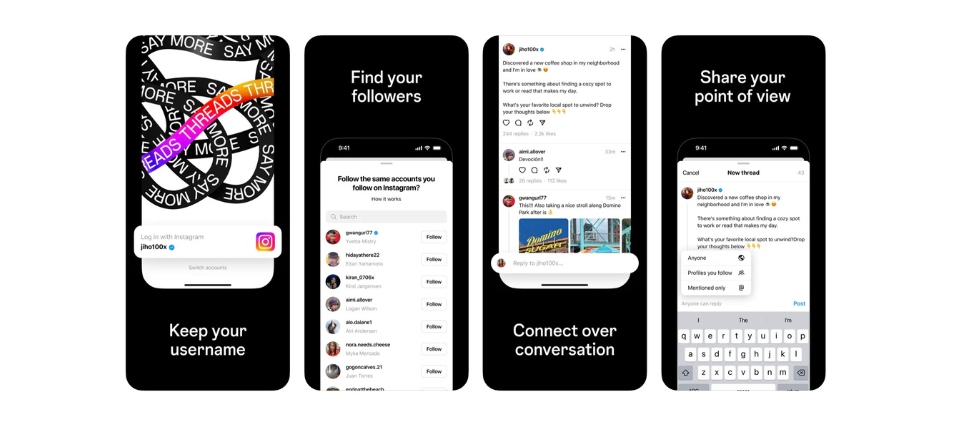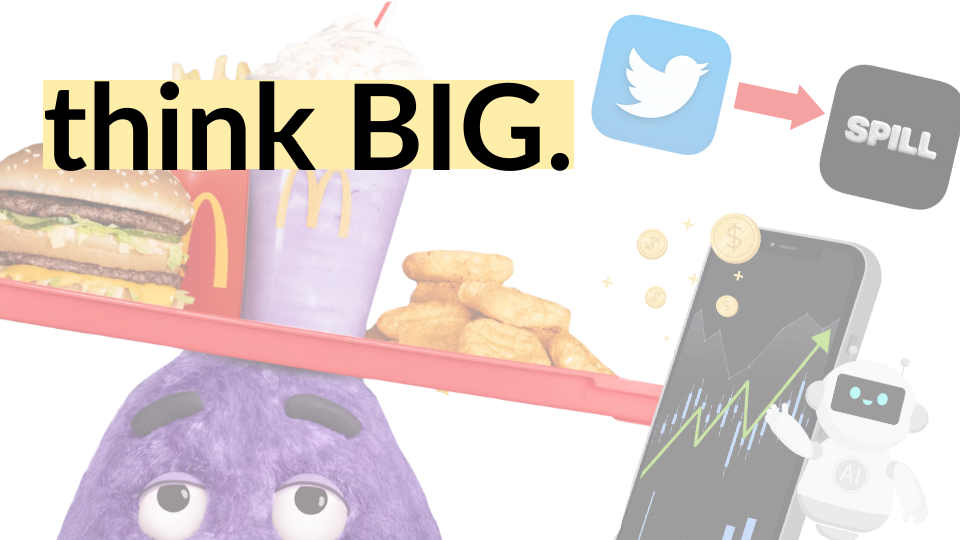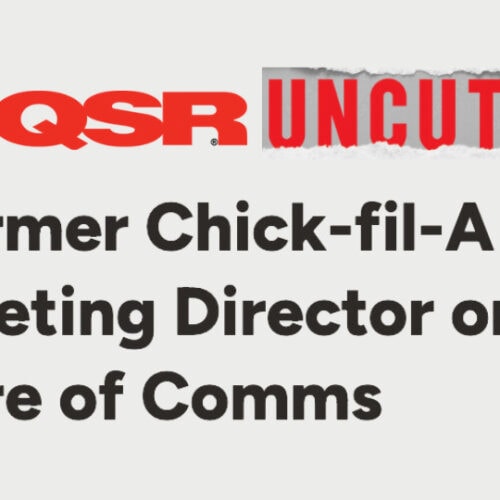Bold Brand Ideas: McDonald’s Grimace shakes up TikTok with this latest trend
Brands don’t make trends. Trends make brands.
In McDonald’s case, their limited-time shake became a cultural phenomenon – thanks to the creativity and savageness of TikTok’s millions of users. TikTok user @thefrazmaz started the #GrimaceShake concept that has now gone viral.
The trend begins with a positive review of the shake. The video then pans to a person covered in the beverage – appearing dead or zombified – with horror music in the background. While the content sounds dark, it’s meant to be lighthearted – and it’s definitely on-brand for the Gen-Z cohort.

The product awareness and buzz has been anything but horrific for McDonald’s. #GrimaceShake now has millions of views on TikTok. It’s been picked up by notable influencers – like @HayleyyBayleyy who has 5 million followers. Hayley’s video has 3 million likes, over 33 thousand comments and 39 thousand shares. That’s millions of free engagements for the brand and its new launch. Friends actor and icon Courteney Cox and her dog have even jumped on the trend.
#GrimaceShake’s media coverage deserves an honorable mention, too. Seriously, type McDonald’s Grimace Shake in Google and be wow-ed by the top tier coverage. Here’s a sample:
- TODAY: McDonald’s Grimace breaks silence on ‘unhinged’ TikTok trend
- Forbes: The McDonald’s Grimace Shake’s Viral (And Gruesome) TikTok Trend, Explained
- New York Times: In a TikTok Trend, Grisly Scenes of Purple Milkshake Horror
- HuffPost: Hilarious TikTok Trend Is Turning McDonald’s Grimace Into A Horror Villain
Some question whether McDonald’s had a hand in creating this viral trend. Others attribute it to Gen-Z’s unhinged social media habits. Either way, brands can learn a few things:
- (Quickly) embrace the unexpected. Sometimes, it’s the quirkiest ideas that catch fire and create a buzz. Lean into cultural moments that are surprising or may give legal pause (senior marketers – if you know, you know). Understanding and tapping into trends, memes and references allows brands to stay relevant and establish meaningful connections. A caveat: marketers should always consider potential brand risks or value misalignments with trends. Another caveat: These trends come and go without a moment’s notice. If you’re going to lean in, lean in quickly. Participating in outdated trends can have the opposite effect and make your brand feel outdated or irrelevant.
- Playfulness and nostalgia are the secret ingredients that shake up routine launches or limited time offers. McDonald’s humanized a beloved and nefarious character, Grimace, and made him the center of their campaign. It was the perfect set up for a social field day. After the fact, McDonald’s acknowledged the trend with this Tweet and prolonged the hype. When planning launches, consider emotional or nostalgic ties to your brand for social users to have fun with.
- User-generated content (UGC) trumps all. TikTok thrives on authentic and relatable content produced by its users. UGC can be leveraged as word-of-mouth marketing and often receives better engagement than brand posts. When creating campaign concepts, marketers should consider how social users can participate and amplify awareness themselves.
The bottomline? The #GrimaceShake social trend sparked big IRL demand, driving higher than anticipated sales and foot traffic. Not to mention, a bustling eBay market for related memorabilia.
Industry Insights: This new social platform is uplifting Black creators + addressing inequalities
Speaking of trends… There’s a new social platform in town: Spill. Spill describes itself as “visual conversation at the speed of culture.” According to Mashable, the app is intended to foster a safer, more diverse community for what the founders call ‘culture drivers’.
The platform will have live feeds where users can “spill the tea” and start wide-reaching conversations. Users are encouraged to share their thoughts with meme + GIF-like content. Spill will also have “tea parties” where users can host online or IRL events for community sub-groups.

Spill was created after its founder, Alphonzo “Phonz” Terrell, saw the exploitation of Black cultural contributions on social apps. He noticed that Black creators were creating viral trends monetized by other influencers and brands – without the credit or profit.
The newest social site is committed to changing that reality by recognizing Black creators’ contributions. It plans to monetize creators with blockchain technology.
The platform also plans to further foster an inclusive community by filtering out hate speech and biases. Specifically, Spill is creating an AI moderation model that detects signs of online harm and considers AAVE (African American vernacular English). Studies have found that Tweets written in AAVE are 2.2 times as likely to be mistakenly flagged as offensive because AI can’t detect the cultural context. Spill’s CTO is determined to combat that bias and make the platform a safe space.
Spill is undergoing beta testing now and has a waitlist. Although not fully rolled out, it’s continuing to build traction – especially in light of Twitter’s new restrictions.
The community-first platform is trailblazing safer social media, and is one for advertisers, creators and users to keep an eye on.

Threads (seen above), built by the Instagram team, is another Twitter rival that marketers are watching.
Twitter has left users unsatisfied with its verification costs and aforementioned restrictions. Threads swooped in with old school Twitter features that users have missed. The app allows text updates up to 500 characters; ability to attach links, photos and videos up to five minutes long; and the ability to interact with content threads via likes, replies and reposts.
Because of its newness, monetization is undetermined with users loving the “ad free zone.” It’s giving 2009 Twitter vibes, and users are here for it. That said, we can speculate that Threads was launched as an easy new source of revenue. Marketers anticipate that Meta will soon encourage brands to expand their Facebook + Instagram ads to Threads.
Threads will likely have more stickness than newer concepts, like Spill, due to its Meta connection. Plus, Instagram users can easily sign up for Threads with their followers transferring over.
We recommend securing your handle and organically interacting with audiences through quotes and replies. It often pays to be an early adopter.
Goals: AI’s qualitative impact on marketing results
Performance marketing is not a new concept, but it has become a hot button topic in today’s economy. Brand marketers are tasked to do more with less. Cue: AI, a tool that is not replacing jobs, but making them more efficient and effective. From data analysis to customer personalization, AI can help improve marketing outcomes and drive better business results.
According to a Marketing Charts survey, 59% of respondents cited generative AI as the most important trend of 2023. AI even ranked higher than TikTok and social video.
Why is that? Consider a few ways AI can inform better strategies that drive results:
- Data Analysis and Insights: AI-powered analytics tools intake a vast amount of data in real-time, extracting valuable insights and trends that can inform marketing strategies. By analyzing consumer behavior, preferences and purchase patterns, AI can provide marketers with a deeper understanding of their audiences. This data-driven approach drives informed decisions, in-touch messaging and optimized campaigns.
- Predictive Analytics and Forecasting: AI’s analysis of large data sets also helps identify patterns, supporting predictive analytics and forecasting. By leveraging historical data, AI algorithms can predict things like consumer trends, demands and rising interests. These insights enable marketers to anticipate market shifts and adjust strategies accordingly. This real-time data is core to an agile approach that leverages “Objectives + Key Results” over KPIs.
- Enhanced Customer Personalization: AI can inform personalized marketing experiences. By analyzing customer data, AI algorithms can segment audiences and create tailored recommendations, offers and content. This level of customization helps build stronger connections with customers to increase engagement. AI-powered chatbots also contribute to personalized customer experiences by providing instant, accurate and context-specific interactions.
AI can also be used for research support (make sure to fact check!) and creative thought starters. ChatGPT was the catalyst for this section of our Think BIG blog. 😉
And remember: insights from AI are the start to a marketing plan. A strategic marketer’s experience, intuition and industry knowledge will ultimately drive performance.
How is your team leveraging AI in your day to day? What tips and tricks are making your job easier?
Fill out the form below to be notified when our next Think BIG blog publishes.




